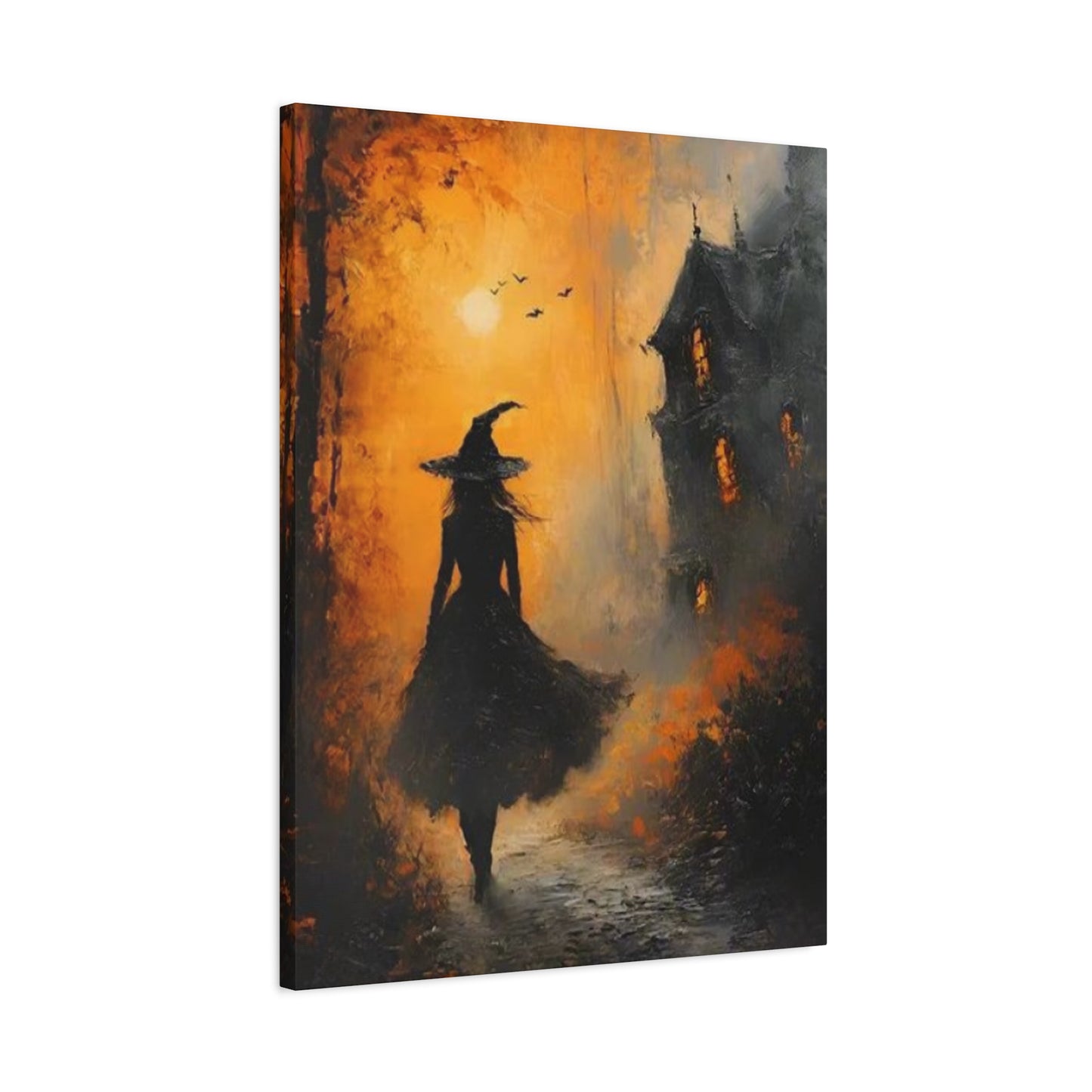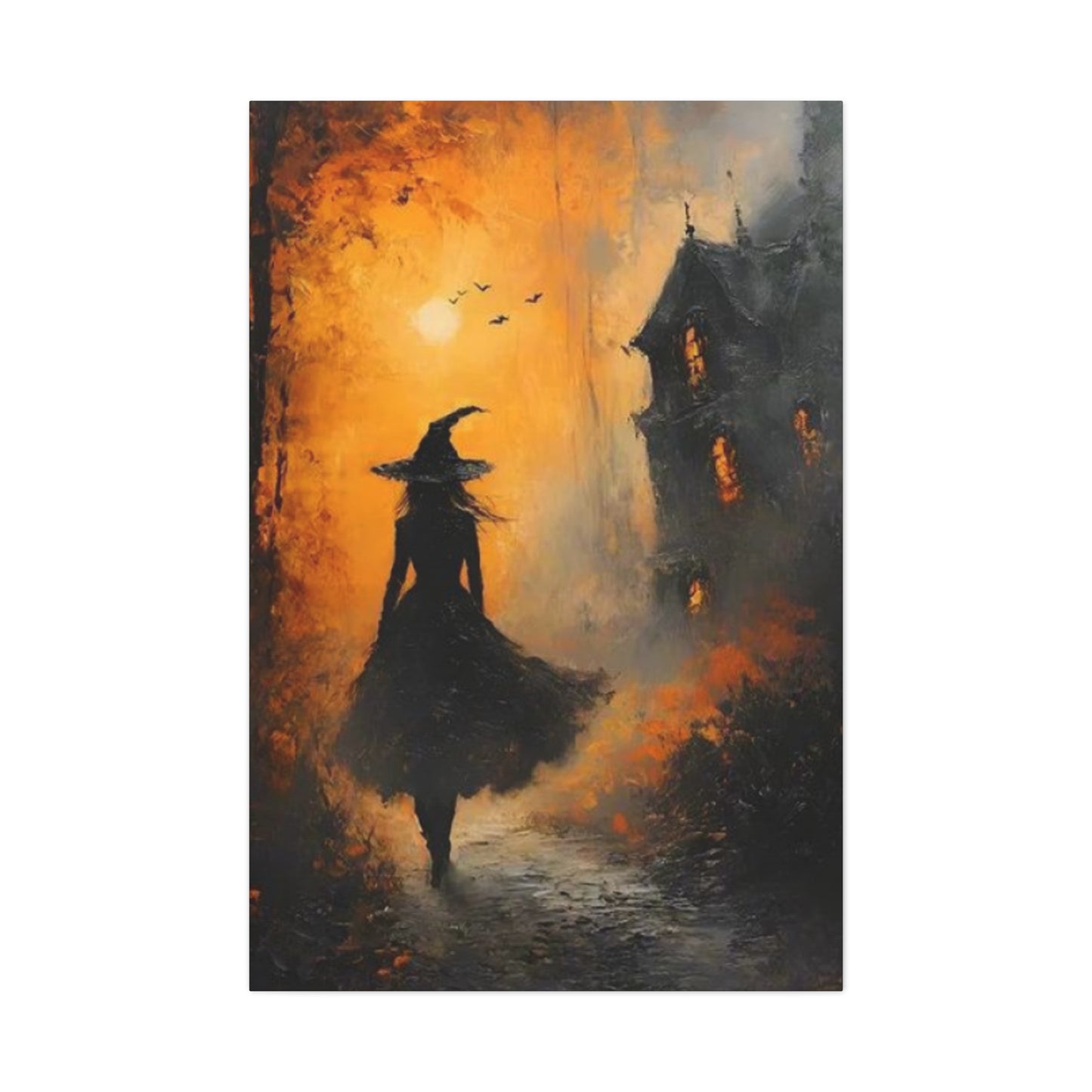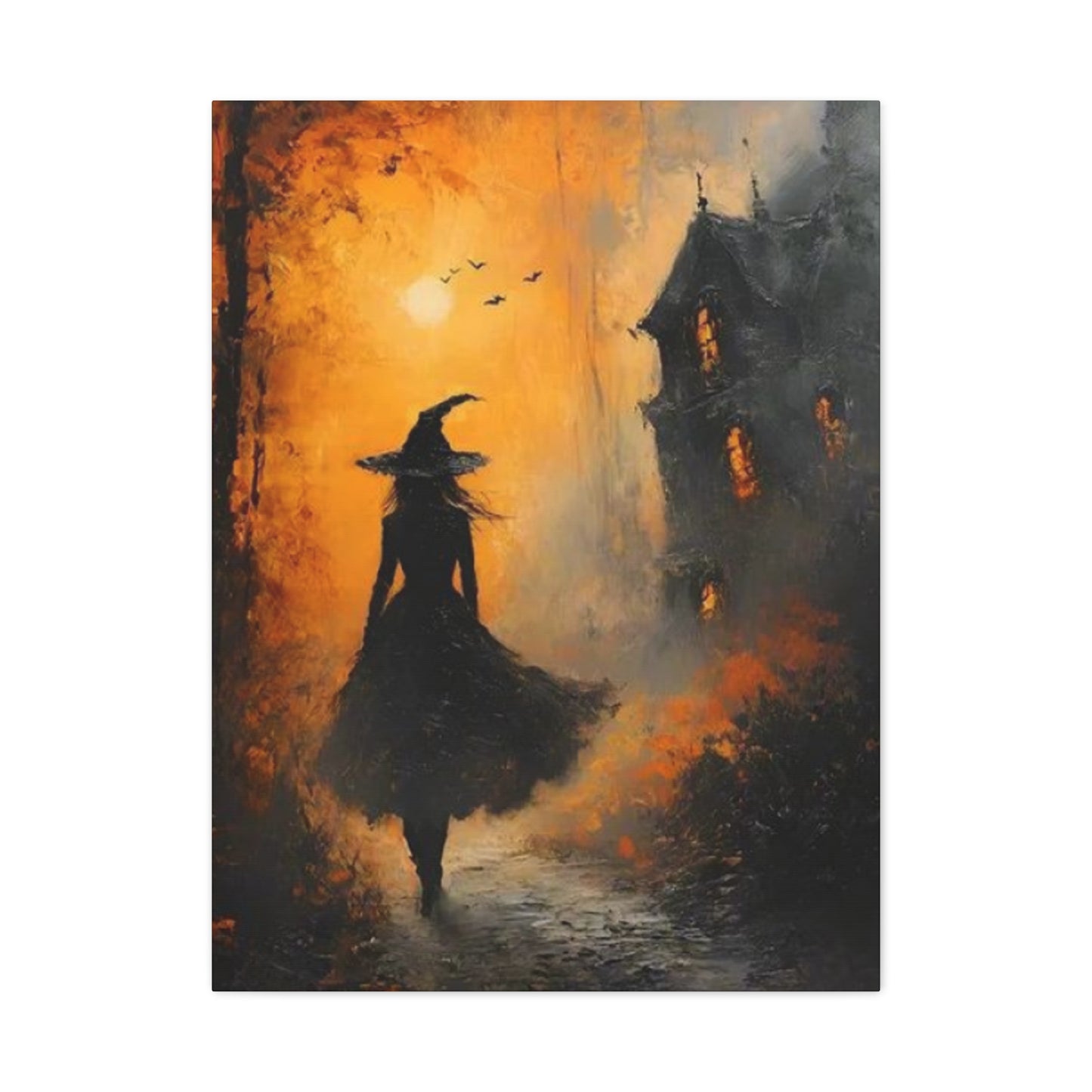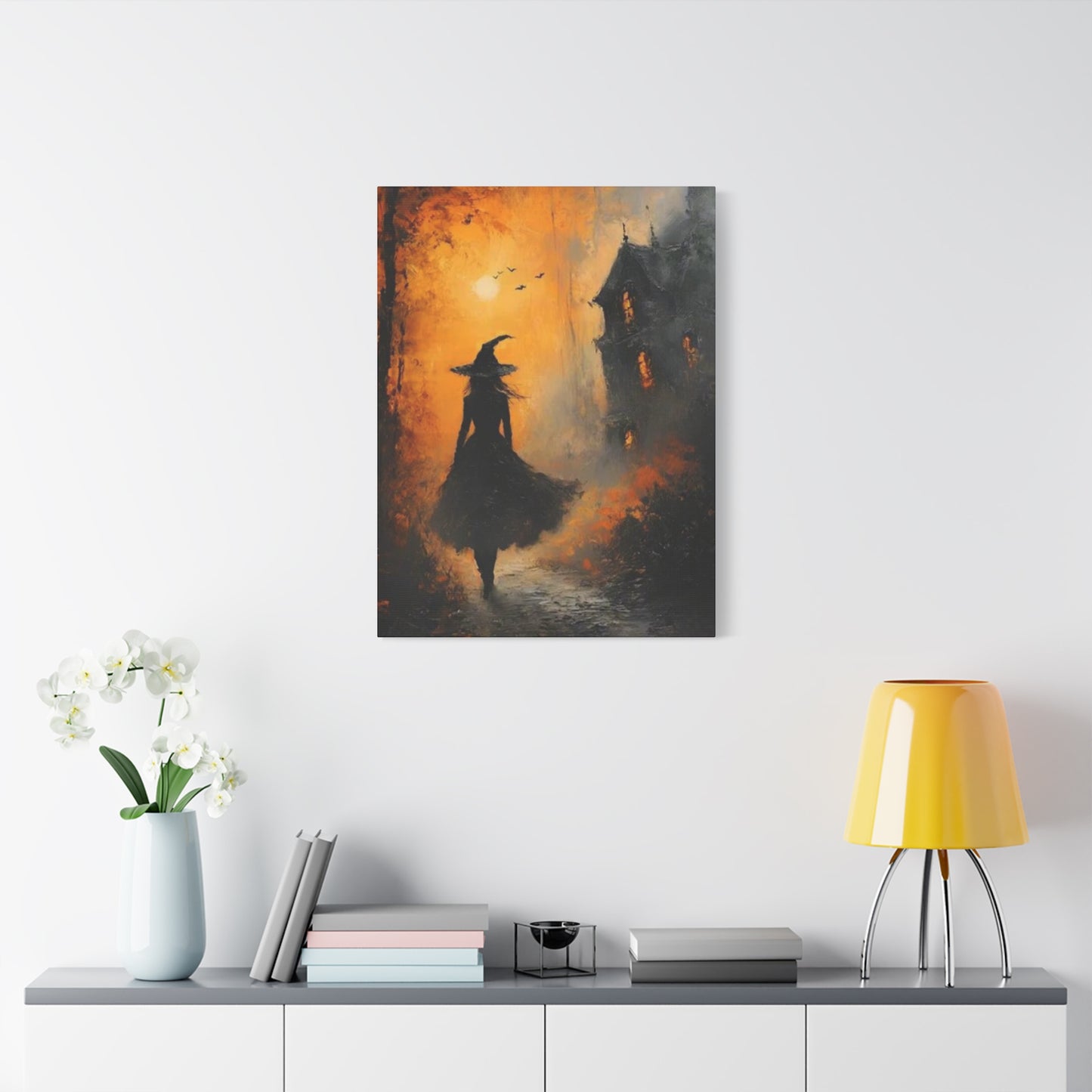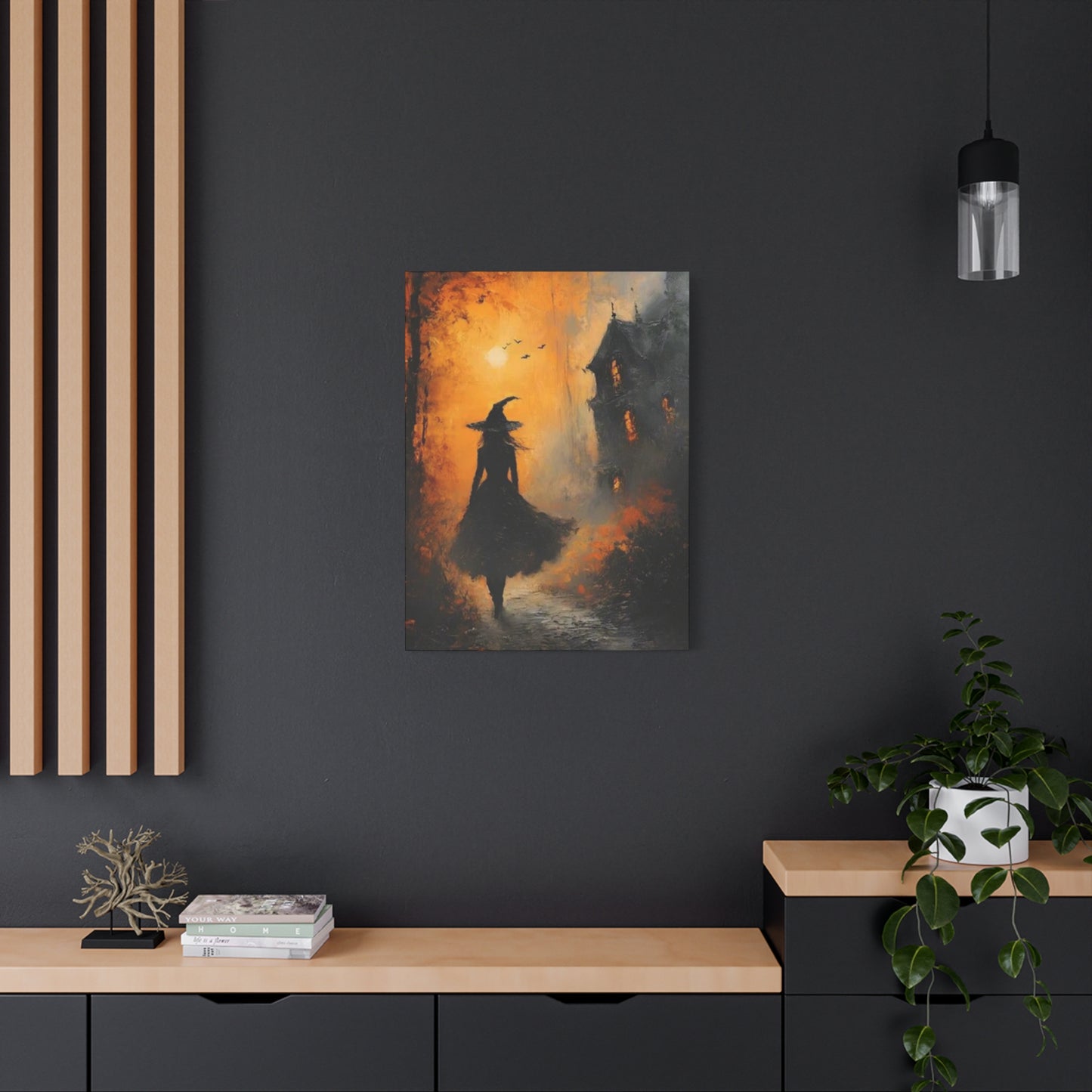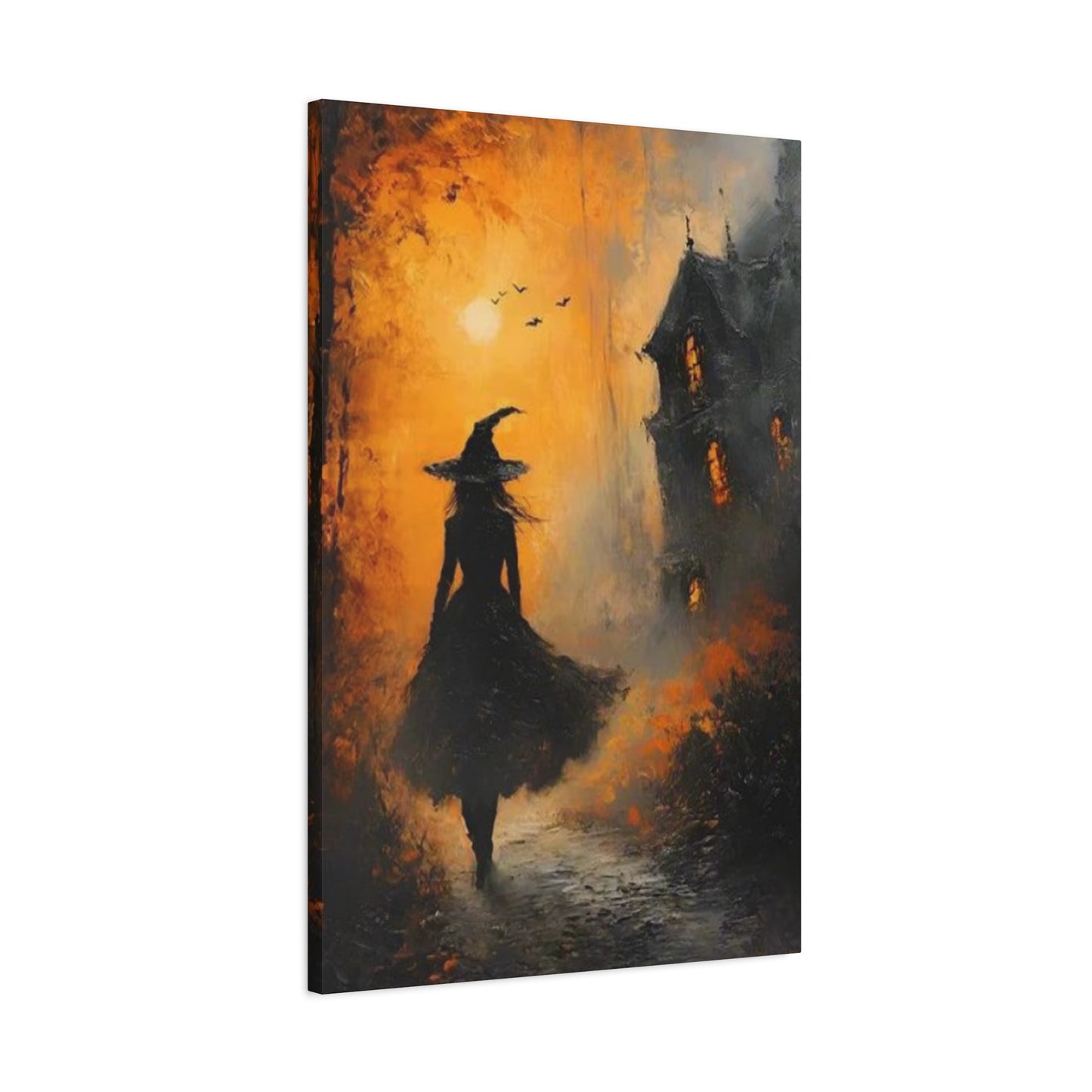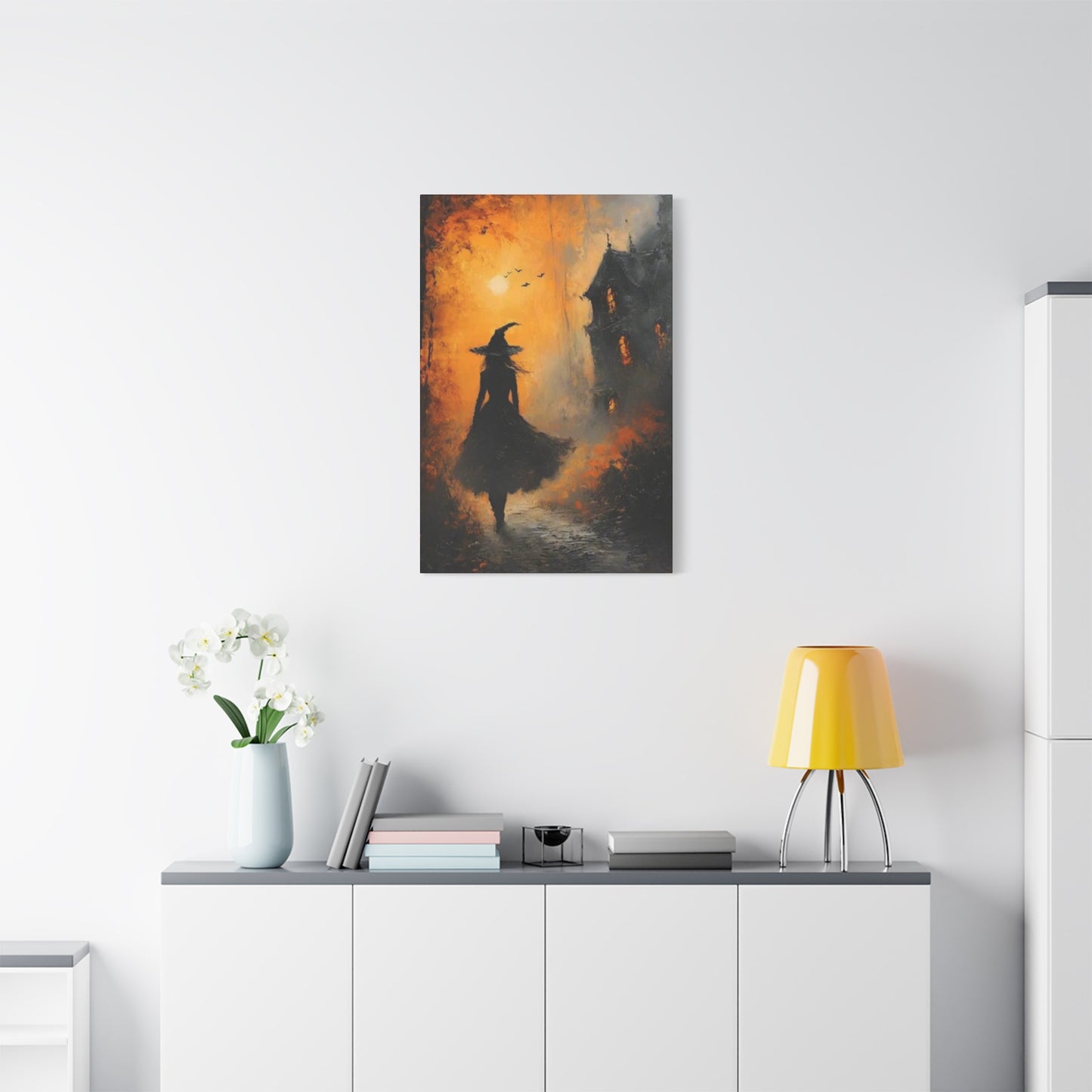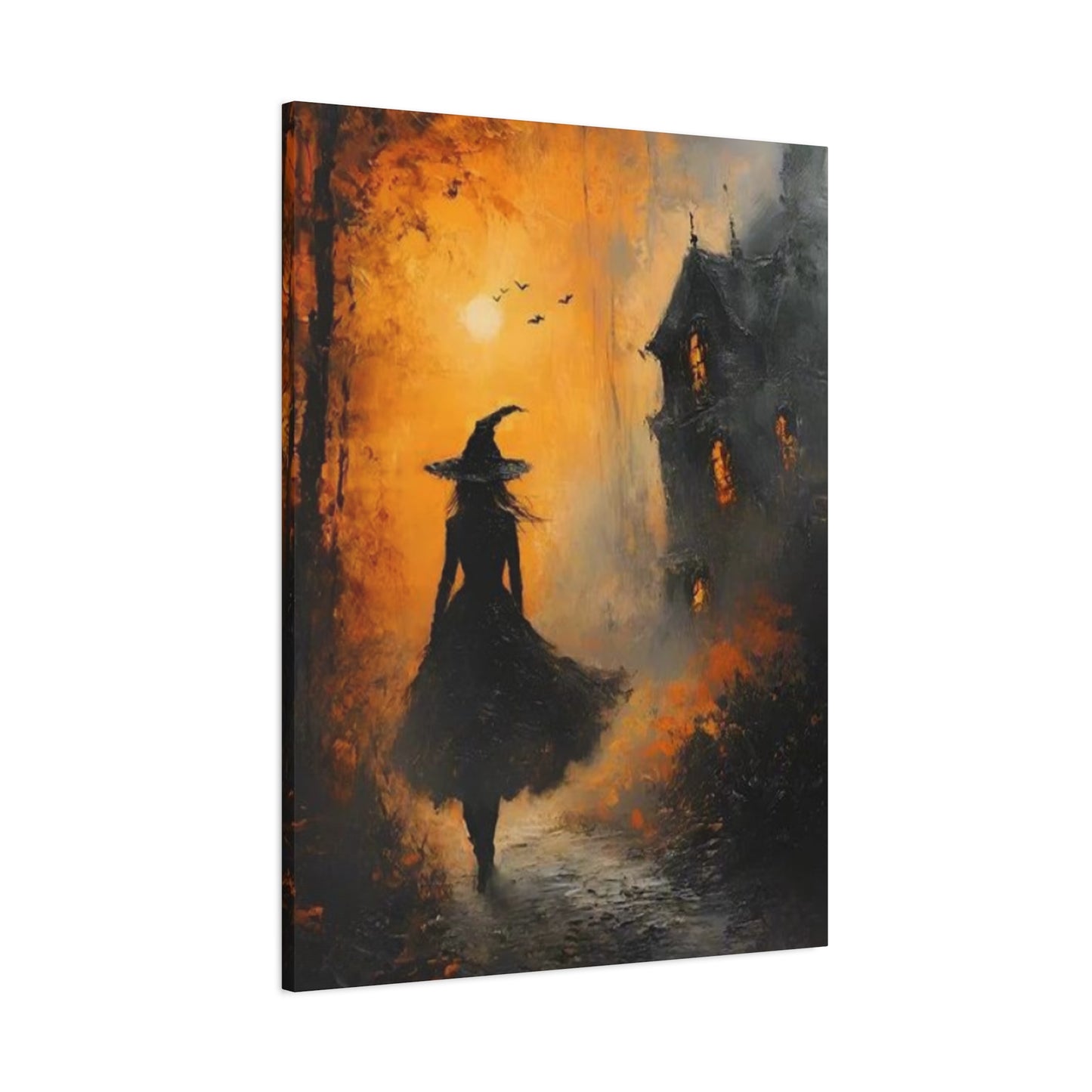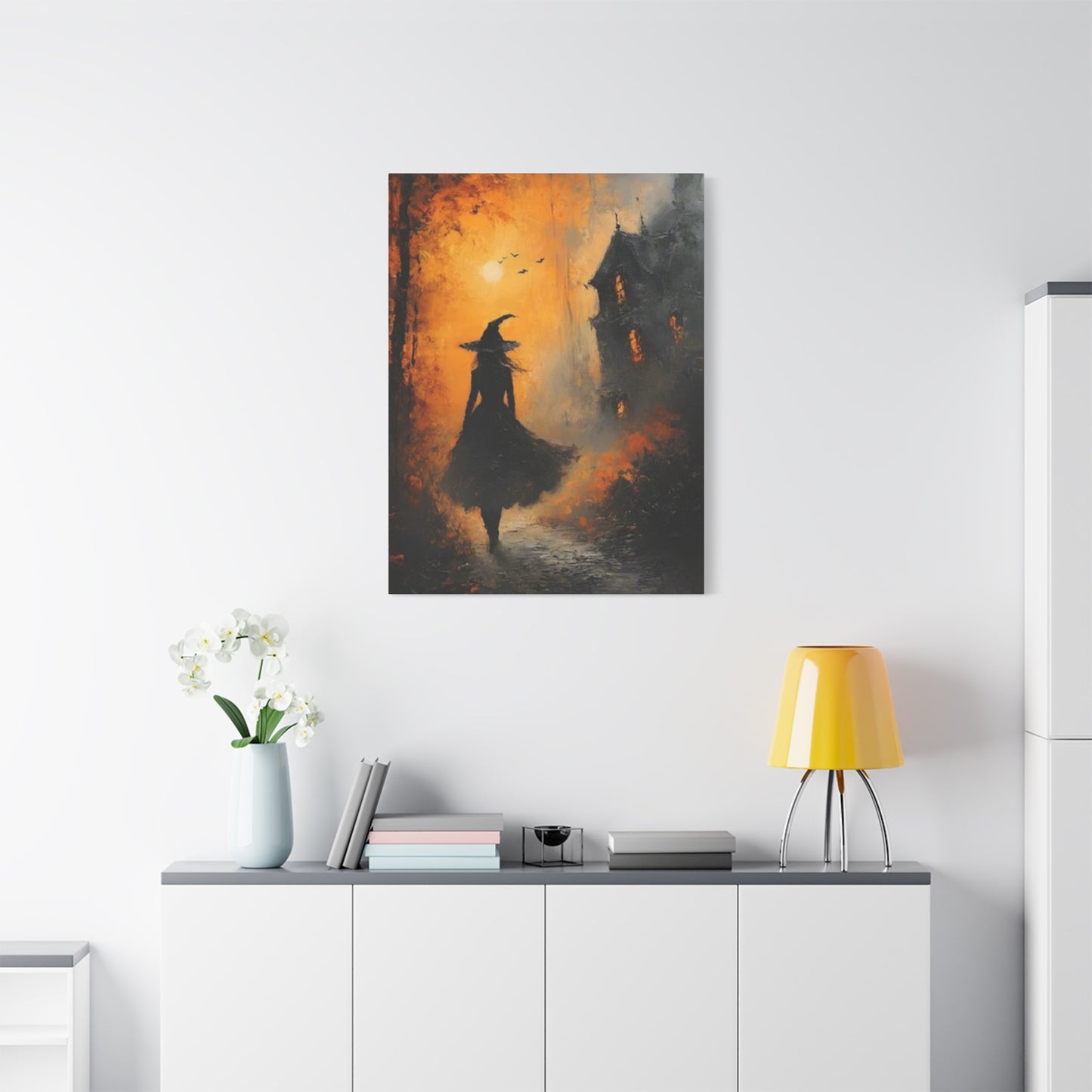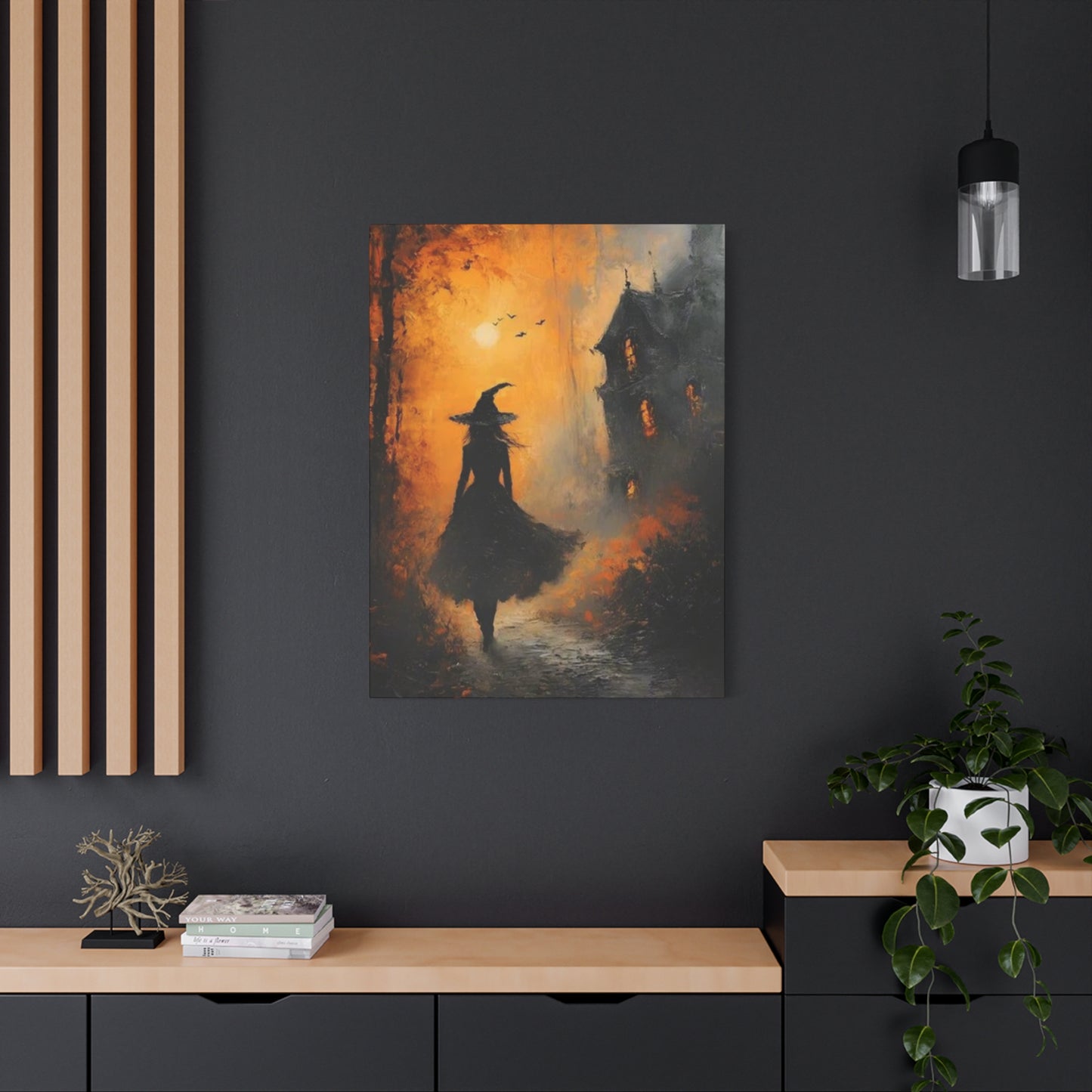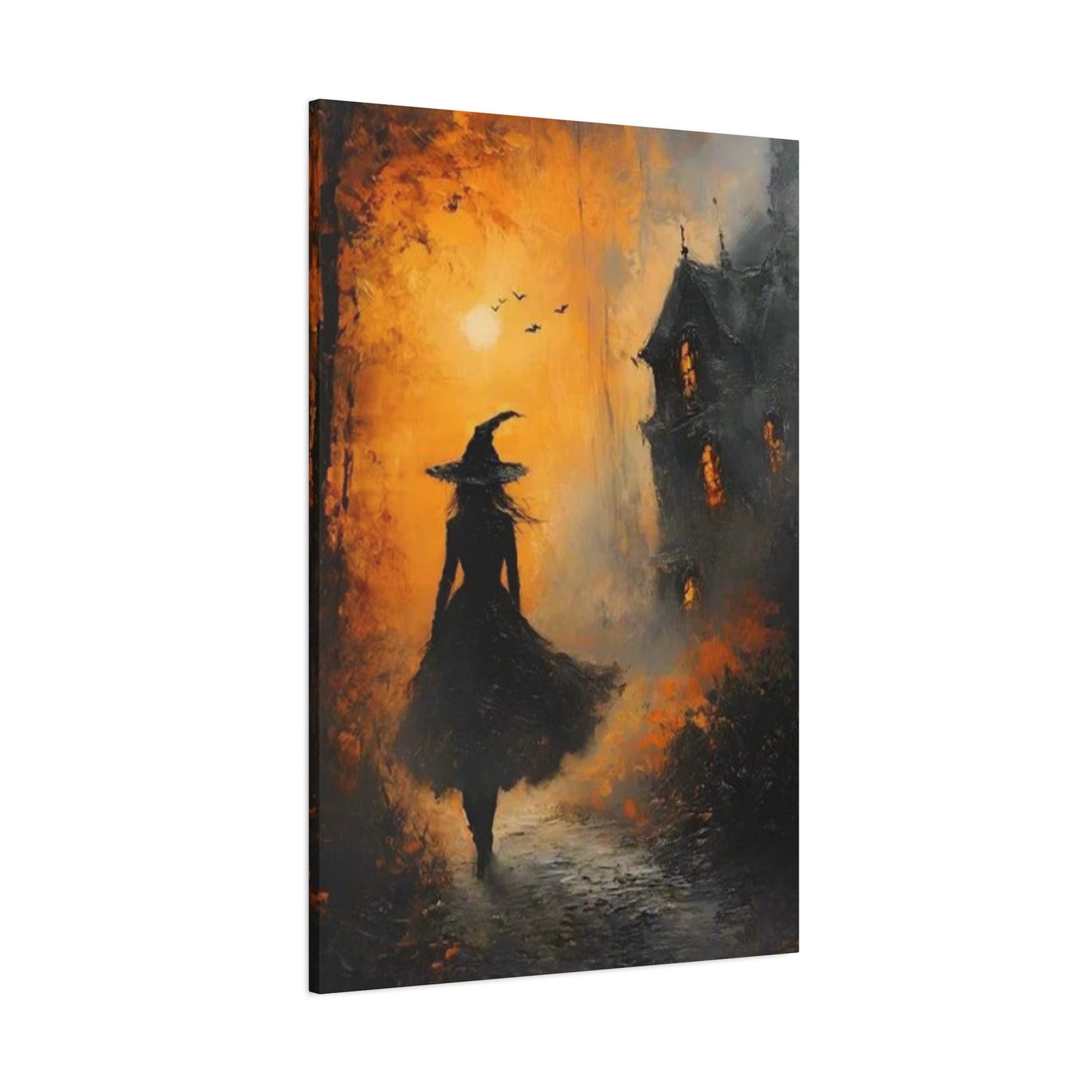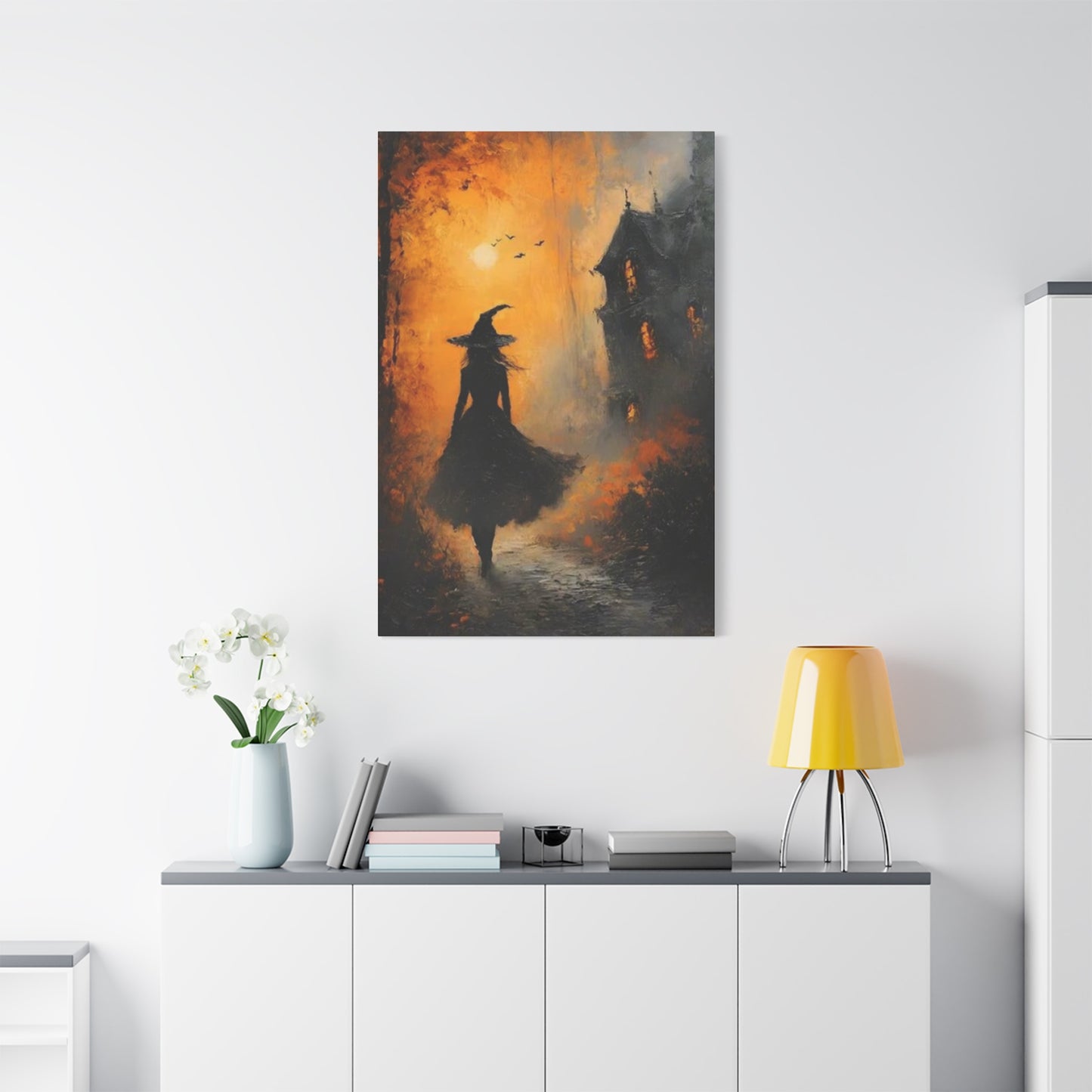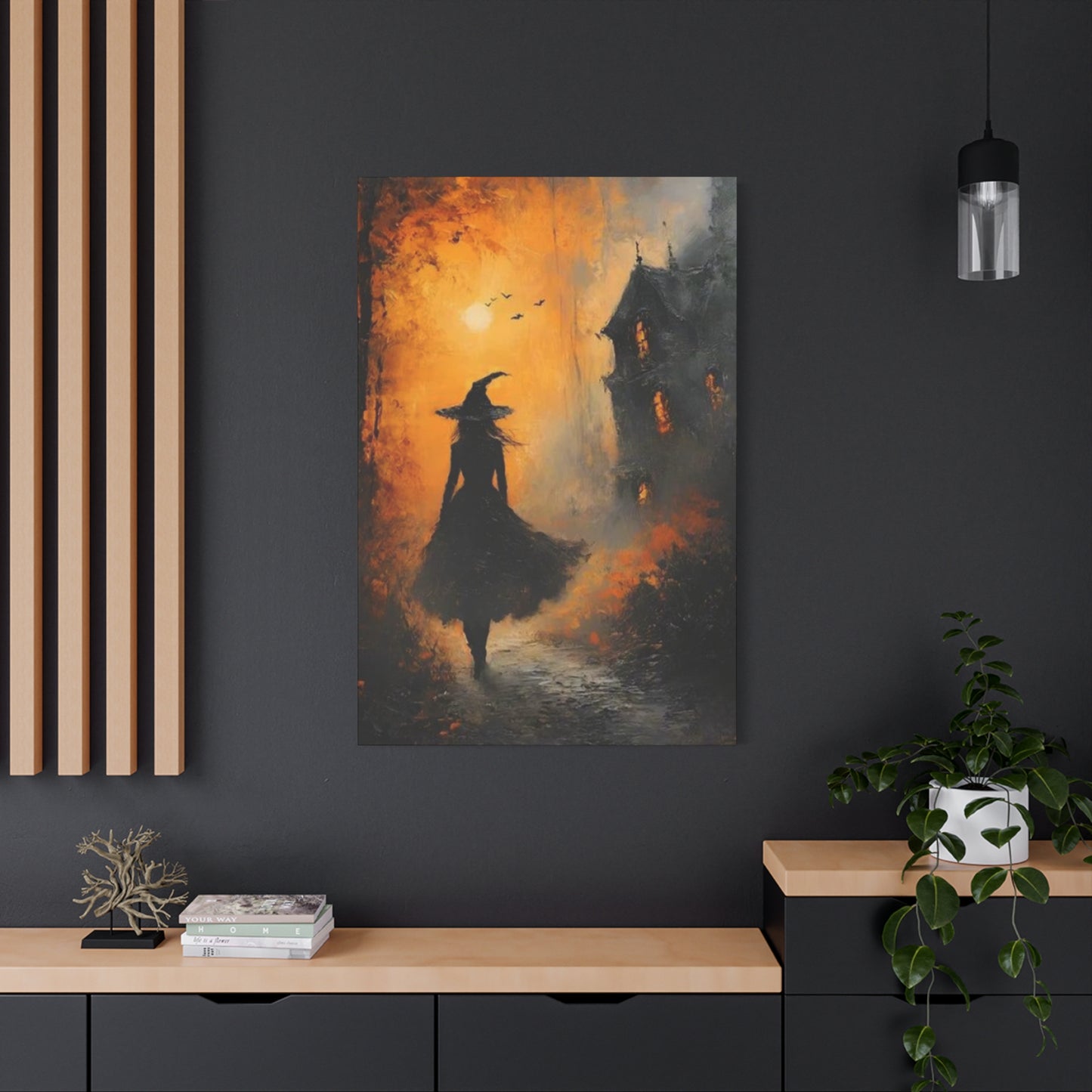Eerie Elegance: A Deep Dive into Halloween Scary Painting Wall Art Prints
The rustle of autumn leaves, the crispness in the air, and the lengthening shadows all signal the approach of a season steeped in mystery and macabre delight. It is a time when the veil between worlds feels thin, and our fascination with the spooky, the supernatural, and the strange comes to the fore. This fascination extends beyond costumes and candy, finding a sophisticated and enduring expression in home decor. At the heart of this decorative evolution lies the powerful medium of art, specifically Halloween scary painting wall art canvas prints. These pieces are not mere seasonal novelties; they are curated expressions of atmosphere, storytelling, and personal taste. They allow us to transform our living spaces into immersive environments that celebrate the spirit of Halloween with an artistic flair. This exploration delves into the multifaceted world of scary canvas art, examining its historical roots, psychological impact, stylistic diversity, and the profound ways it enhances our experience of the most haunted of holidays.
The Enduring Allure of Macabre Aesthetics in Home Decor
The human psyche has always held a deep-seated fascination with the macabre. This attraction to the dark, the mysterious, and the terrifying is not a modern phenomenon but a timeless thread woven through the tapestry of human culture. In the realm of home decor, this inclination manifests as a deliberate embrace of aesthetics that challenge conventional notions of beauty and comfort. The allure of macabre design, particularly through Halloween scary painting wall art canvas prints, lies in its ability to evoke powerful emotions and create a uniquely atmospheric environment. It is a rebellion against the mundane, an invitation to explore the shadowy corners of our imagination from the safety of our own homes. Incorporating scary paintings into a living space is a statement of intellectual curiosity and artistic bravery. It suggests a personality that appreciates depth, complexity, and the full spectrum of human experience, including its darker aspects.
These pieces serve as conversation starters, prompting discussions about art, fear, and the nature of storytelling. A canvas depicting a spectral figure in a desolate forest or a close-up of a creature from folklore does more than just fill a space on a wall; it infuses the room with a narrative, a sense of history, and an undercurrent of suspense. The enduring appeal also stems from the sophisticated artistry involved. Many scary paintings are masterpieces of technique, utilizing chiaroscuro, unsettling perspectives, and symbolic imagery to create their chilling effects. When rendered on high-quality canvas, the textural details and color depth are amplified, turning a potentially shocking image into a piece of fine art. This elevates the decor from simple seasonal decoration to a curated collection that reflects a discerning eye. Ultimately, the charm of macabre aesthetics is about creating a space that feels personal, evocative, and alive with stories waiting to be told.
Exploring the Origins of Fear in Artistic Expression
The tradition of depicting fear and horror in art is as old as art itself. From the grotesque demons adorning medieval cathedrals to the haunting specters of Japanese Ukiyo-e prints, artists have perennially sought to capture the essence of what terrifies us. The origins of this artistic exploration are deeply rooted in human psychology, mythology, and social history. Early art served functional and spiritual purposes, often illustrating cautionary tales or personifying the unknown forces of nature. Paintings of mythological monsters, vengeful gods, and hellish landscapes were not merely for entertainment; they were powerful tools for religious instruction and social control, reinforcing a community's beliefs and moral codes.
The Romantic movement of the late 18th and early 19th centuries marked a significant shift, as artists began to explore the sublime—the experience of awe mixed with terror. Painters like Francisco Goya with his "Black Paintings" and Henry Fuseli with "The Nightmare" delved into the internal landscapes of the human mind, portraying dreams, madness, and a profound sense of psychological dread. This was a pivotal moment, as fear in art moved from an external, mythological threat to an internal, psychological one. The advent of Gothic literature further fueled this artistic trend, providing a rich wellspring of imagery—haunted castles, melancholic vampires, and tragic monsters—that artists eagerly translated onto canvas. The development of Halloween scary painting wall art canvas prints is the modern inheritor of this long and storied tradition. It draws upon this vast historical and iconographic library to create works that resonate with our contemporary anxieties and fascinations
Selecting the Perfect Scary Canvas Print for Your Space
Choosing the right piece of Halloween scary painting wall art canvas prints is a highly personal and creative process that goes far beyond simply picking a spooky image. It involves a thoughtful consideration of the existing decor, the desired atmosphere, and the specific emotional response you wish to evoke. The first step is to assess the room's current aesthetic. Is your style modern and minimalist, rustic and traditional, or eclectic and bohemian? A minimalist space might benefit from a stark, high-contrast piece with a single, unsettling focal point, such as a shadowy figure against a white background. This creates a powerful visual statement without overwhelming the room's clean lines.
Conversely, a more traditional or gothic-inspired room can accommodate a more detailed and ornate painting, perhaps one depicting a classic haunted mansion scene with rich, dark colors and intricate architectural details. The next consideration is the desired mood. Are you aiming for a playfully spooky ambiance suitable for family gatherings, or a genuinely unnerving atmosphere for a more adult-themed horror experience? For a lighter touch, consider art that employs classic Halloween motifs like whimsical skeletons, stylized jack-o'-lanterns, or charmingly rendered ghosts. For a more intense effect, look for works that delve into psychological horror, surrealism, or body horror, using distorted figures, ambiguous narratives, and a more visceral visual language. The scale and placement of the canvas print are also crucial.
A large, dramatic piece can serve as the centerpiece of a room, commanding attention and setting the tone for the entire space. It works best on a large, otherwise empty wall, such as above a sofa or fireplace. A series of smaller prints, on the other hand, can be arranged into a gallery wall, allowing you to tell a more complex story or showcase a variety of horror subgenres. This approach offers flexibility and can be integrated more subtly into a room. Pay attention to the color palette. The colors in the artwork should complement or intentionally contrast with the colors of your walls, furniture, and other decor. A painting with deep reds, blacks, and grays can add a sense of drama and dread, while a piece with muted, ethereal blues and greens can create a more ghostly and melancholic feel. Ultimately, the perfect scary canvas print is one that resonates with you personally and successfully transforms your space into the exact kind of haunted haven you envision.
Masterpieces of Horror: Iconic Themes in Halloween Paintings
The world of Halloween scary painting wall art canvas prints is rich with iconic themes that have captivated and terrified audiences for generations. These recurring motifs serve as a visual shorthand for horror, tapping into a collective cultural consciousness of fear. One of the most enduring themes is the haunted house. Whether depicted as a grand, decaying Victorian mansion on a desolate hill or a humble, seemingly normal suburban home with a dark secret, the haunted house represents the perversion of the domestic space—the place where we are supposed to feel safest becomes the source of our greatest terror. Paintings on this theme often use architectural elements like looming gables, dark windows that look like eyes, and overgrown gardens to create a sense of malevolent personality within the structure itself. Another central theme is the monstrous figure.
This can range from classic literary monsters like vampires, werewolves, and Frankenstein's creation to more abstract and eldritch horrors inspired by cosmic horror. These paintings explore fears of the other, the loss of humanity, and the breakdown of the natural order. The artist's rendering of the monster—its anatomy, expression, and posture—is key to its effectiveness, aiming to evoke a mix of fear, pity, and revulsion. The supernatural and the spectral form a third major category. Ghosts, phantoms, and ethereal presences are a staple of scary art. These works often play with transparency, light, and shadow to create a sense of the intangible and the otherworldly. The horror comes not from a physical threat but from the chilling implication of a reality beyond our own, a world of spirits that coexists with and sometimes intrudes upon ours. The occult and witchcraft provide another fertile ground for artistic exploration.
Paintings depicting rituals, demonic summoning, and arcane symbols tap into fears of forbidden knowledge and malevolent forces being unleashed upon the world. These pieces are often rich in symbolism, requiring the viewer to decode their hidden meanings. Finally, there is the theme of the psychological landscape, where the horror is not external but internal. These surreal and abstract paintings visualize states of madness, anxiety, and paranoia. They use distorted perspectives, nightmarish juxtapositions, and unsettling imagery to take the viewer on a journey into the darkest corners of the human mind. Each of these iconic themes offers a different flavor of fear, allowing art lovers to curate a collection that reflects their specific taste in terror.
From Gothic to Modern: Evolving Styles of Scary Paintings
The stylistic evolution of scary paintings mirrors the broader changes in art history and societal anxieties. What we find frightening and how we choose to depict it has transformed dramatically over the centuries, leading to a diverse range of styles available in Halloween scary painting wall art canvas prints. The journey begins with the Gothic style, which emerged in the late 18th century alongside Gothic literature. Characterized by romanticism, melodrama, and a fascination with the medieval past, Gothic art is filled with ruined abbeys, moonlit graveyards, tormented heroes, and supernatural beings. The mood is one of sublime terror and melancholic beauty. The color palettes are typically dark and dramatic, with a focus on creating a sense of atmosphere and historical weight. As we move into the 20th century, the Symbolist and Surrealist movements offered new ways to explore horror.
Artists like Edvard Munch and Max Ernst turned inward, seeking to portray the landscape of the subconscious. Their work is less about narrative and more about emotion and psychological states. This style is characterized by distorted figures, dreamlike logic, and bizarre juxtapositions of ordinary objects. Surrealist horror art is deeply unsettling because it taps into the uncanny, making the familiar strange and threatening. The mid-20th century saw the rise of cinematic horror, which had a profound influence on painting. The aesthetics of German Expressionist film, with its sharp angles and dramatic shadows, and later, the graphic imagery of slasher and monster movies, found their way onto canvas.
This style is often more direct and visceral, focusing on moments of peak terror and explicit gore, mirroring the jump scares and shocking reveals of a horror film. In the contemporary era, the styles of scary art are more diverse than ever. We see a resurgence of classical and gothic techniques, but often with a modern, ironic twist. Digital art has opened up new possibilities, allowing for hyper-realistic renderings of fantastical creatures and impossibly complex, nightmarish scenes. There is also a strong trend towards minimalist horror, where the fear is generated through suggestion and subtlety rather than explicit imagery. A single, ominous shape in an otherwise empty room or a landscape that feels just slightly "off" can be incredibly effective. This evolution of styles ensures that there is a scary painting for every taste, from those who appreciate the romantic dread of the Gothic to those who prefer the psychological unease of modern surrealism.
How Canvas Prints Enhance the Terrifying Details of Halloween Art
The choice of medium is crucial for any work of art, and for scary paintings, canvas is an exceptionally effective choice. The properties of this material, especially when used for high-quality prints, can significantly enhance the terrifying details and overall impact of a piece of Halloween art. The texture of the canvas itself is one of its primary advantages. Unlike a flat, glossy photo print, a canvas has a woven texture that adds a tangible depth and a painterly quality to the image. This texture can interact with the artwork's details in compelling ways. For instance, in a painting of a decaying, ancient monster, the subtle weave of the canvas can mimic the texture of rough, leathery skin or crumbling stone, making the image feel more physical and real.
For a ghostly image, the texture can break up the smoothness, adding to the ethereal and insubstantial quality of the figure. Canvas prints are also renowned for their ability to reproduce color with richness and vibrancy. This is particularly important for horror art, which relies heavily on color to establish mood. The deep, velvety blacks that are essential for creating suspense and concealing threats appear more profound and absolute on a matte canvas surface, which absorbs light rather than reflecting it. The stark contrast between these dark areas and any highlights is thus more dramatic. Similarly, the visceral impact of a splash of blood red or the sickly green glow of a supernatural light is intensified by the color saturation that canvas can achieve. Another key benefit is the elimination of glare. A glossy print can be difficult to view under certain lighting conditions due to reflections.
A canvas print, with its matte or satin finish, can be viewed from any angle without distracting glare. This is crucial for art that relies on subtle details hidden in the shadows. The viewer can fully immerse themselves in the scene, exploring every dark corner, without being pulled out of the experience by a reflection of a lamp or window. The gallery-wrapped presentation of many canvas prints also contributes to their impact. The image extends around the edges of the wooden frame, creating a clean, modern, and three-dimensional object. This frameless look allows the artwork to feel more immediate and present, as if the terrifying scene is a window directly into another world, unconstrained by the formal boundary of a traditional frame. This combination of texture, color depth, lack of glare, and presentation makes canvas the ideal medium for bringing the chilling details of scary paintings to life.
Curating a Cohesive Gallery Wall of Spooky Masterpieces
Creating a gallery wall is a popular and dynamic way to display art, and applying this concept to a collection of Halloween scary painting wall art canvas prints can result in a stunning and atmospheric feature in any home. A well-curated spooky gallery wall is more than just a random assortment of scary pictures; it is a thoughtfully arranged collection that tells a story or explores a specific theme, creating a powerful cumulative effect. The first step in curating a cohesive wall is to decide on a unifying element. This could be a theme, a style, an artist, or a color palette. For a thematic approach, you could focus on a specific horror subgenre. For example, a "Gothic Romance" wall could feature canvases of haunted castles, melancholic vampires, and spectral figures in flowing gowns. A "Cosmic Horror" wall might display abstract, tentacled monstrosities and unsettling, alien landscapes.
A "Folklore and Mythology" theme could bring together paintings of witches, werewolves, and other legendary creatures from around the world. Alternatively, the unifying element could be stylistic. You might choose to collect only black-and-white pieces, creating a classic, film noir-inspired look. Or you could focus on a specific art style, such as surrealism, creating a wall of dreamlike and psychologically disturbing images. Using a consistent color palette is another effective strategy. You could select pieces that all share a dominant color, such as deep crimson or moody indigo, or that adhere to a specific palette of muted, autumnal tones. This creates a sense of visual harmony, even if the subject matter of the individual pieces varies. Once you have your collection, the layout is key.
Before putting any nails in the wall, arrange the canvases on the floor to experiment with different configurations. You can opt for a structured, symmetrical grid for a formal and organized look, or an organic, "salon-style" arrangement for a more eclectic and dynamic feel. A good practice is to start with the largest piece, placing it in a central or off-center anchor position, and then building the arrangement around it with the smaller pieces. Pay attention to the spacing between the frames, keeping it relatively consistent to maintain a sense of order. The final result is a personalized museum of the macabre, a feature wall that not only celebrates the Halloween season but also showcases your unique taste and passion for the art of horror.
The Symbolism of Classic Halloween Imagery in Paintings
The imagery we associate with Halloween is laden with deep-seated symbolism and cultural history, and artists who create scary paintings often tap into this rich symbolic language to add layers of meaning to their work. Understanding these symbols can deepen our appreciation for a piece of Halloween scary painting wall art canvas prints, revealing the narrative and emotional currents flowing beneath the surface. The jack-o'-lantern, for example, is one of the most ubiquitous Halloween symbols. Originating from the Irish myth of Stingy Jack, a man who tricked the devil and was condemned to roam the earth with only a burning coal inside a carved-out turnip to light his way, the jack-o'-lantern symbolizes a lost, wandering soul and a protective ward to frighten away evil spirits. In a painting, a glowing jack-o'-lantern can create a feeling of both festive spookiness and profound loneliness or menace, depending on its expression and context.
Skeletons and skulls are universal symbols of death and mortality. In Halloween art, they serve as a memento mori, a reminder of our own finitude. However, they can also be portrayed in a playful or celebratory manner, as seen in the "Danse Macabre" (Dance of Death) tradition or the iconography of Mexico's Día de los Muertos. A painting featuring skeletons might be a chilling reminder of the grave, or it could be a lively, carnivalesque celebration of life in the face of death. Witches are another potent symbol, representing female power, forbidden knowledge, and a connection to the natural and supernatural worlds. Historically persecuted, the witch has been reclaimed in many contexts as a symbol of rebellion and empowerment. In art, a witch can be depicted as a terrifying, malevolent crone, a seductive enchantress, or a wise, nature-worshipping figure.
The specific portrayal reveals much about the artist's perspective on power, nature, and conformity. Bats, spiders, and black cats are creatures associated with the night, witchcraft, and bad omens. In paintings, they often serve as atmospheric details that enhance the sense of unease and the supernatural. A bat flitting across a full moon or a spider descending on a single thread can instantly signal that the scene is set in a world where the ordinary rules do not apply. By skillfully weaving these and other classic symbols into their compositions, artists create a visual shorthand that instantly connects with our cultural understanding of Halloween, imbuing their work with a timeless and resonant power.
The Role of Color and Shadow in Creating Terrifying Art
In the visual language of horror, color and shadow are arguably the two most powerful tools an artist possesses. Their masterful manipulation is what separates a mildly spooky picture from a truly terrifying work of art. In a Halloween scary painting wall art canvas prints, the strategic use of color and shadow works directly on our psychology to create atmosphere, build suspense, and elicit visceral fear. Shadow, or the absence of light, is intrinsically linked to fear of the unknown. What we cannot see is often more frightening than what we can, as our imagination populates the darkness with our worst fears. Artists exploit this by using vast areas of deep, opaque shadow. A dark hallway, the space under a bed, or the unlit corner of a room become pregnant with terrifying possibility.
The technique of tenebrism, a dramatic form of chiaroscuro, pushes this to the extreme, with figures emerging from a pitch-black background. This not only creates a sense of intense drama but also suggests that the subject has materialized from a void of nothingness, a truly unsettling concept. The shape and quality of shadows are also important. Long, distorted shadows can make an ordinary object or person seem monstrous and menacing. A sharp, hard-edged shadow can feel aggressive and sudden, while a soft, creeping shadow can build a slow, insidious sense of dread. The color palette of a scary painting is a carefully calibrated instrument for emotional manipulation. A monochromatic or limited palette, often using shades of black, white, and gray (grisaille), can create a stark, bleak, and timeless atmosphere, reminiscent of old photographs or classic horror films. It strips the world of its vitality, suggesting a realm of death and decay.
When color is used, it is often done so with specific intent. Desaturated, muddy colors like sickly greens, murky browns, and bruised purples can evoke feelings of disease, rot, and unease. These are the colors of things that are unwell or unnatural. Conversely, the highly selective use of a single, vibrant color within a muted scene can have a shocking effect. A splash of brilliant crimson in a gray-scale painting instantly reads as blood, signaling violence and danger. Unnatural color combinations, such as a sky painted a lurid yellow or a landscape bathed in an eerie blue light, can disorient the viewer and suggest that the scene is taking place in a different reality or a dream state. Through the deliberate and skillful interplay of what is revealed by color and what is concealed by shadow, artists can guide the viewer's emotional journey, creating a masterpiece of terror.
Material Matters: Why Canvas is the Ideal Medium for Horror Art
The physical substance of an artwork contributes significantly to its overall effect, and in the genre of horror, the choice of canvas as a substrate for paintings and prints is particularly fitting. The inherent qualities of canvas lend themselves to the themes and aesthetics of scary art, making it the ideal medium for a Halloween scary painting wall art canvas prints. Its durability, texture, and archival nature all play a role in enhancing the power and longevity of these unsettling images. Canvas has a history and a weight to it that paper or digital screens lack. Made from woven fabric, typically cotton or linen, it has a physical presence that feels substantial and permanent. This sense of permanence can make the terrifying imagery feel more real and impactful.
A monster painted on a sturdy, stretched canvas feels more like a captured artifact or a genuine historical relic than a fleeting image. This physicality can create a fascinating tension with supernatural subject matter, grounding the ethereal and the ghostly in a solid, tangible object. The archival quality of modern canvas and the giclée printing process used for high-quality reproductions is another crucial factor. Horror art, like any art, is something to be collected and preserved. Canvas is resistant to fading and deterioration, ensuring that the vibrant colors and deep shadows of a scary painting will remain potent for decades, if not centuries. This allows a piece of art to become an heirloom, a terrifying tradition passed down through generations. This idea of a haunted object, a painting with a long and perhaps dark history, is a powerful concept in itself, adding another layer of psychological resonance to the artwork.
Furthermore, the versatility of canvas is a major advantage. It can be stretched to massive sizes, allowing for the creation of immersive, mural-like pieces that can dominate a room and create a truly overwhelming atmosphere of dread. It can also be used for small, intimate works that draw the viewer in, forcing them to confront unsettling details up close. The gallery-wrapped edge of a modern canvas print provides a clean, contemporary look that allows the image to stand on its own without the need for a frame, making the nightmare scene feel more immediate and boundless. These material properties—its historical weight, archival permanence, and versatile presentation—combine to make canvas not just a surface, but an active participant in the storytelling of horror art.
The Cultural Significance of Scary Art Across Different Traditions
While Halloween as we know it has predominantly Western roots, the impulse to create art that explores fear, death, and the supernatural is a universal human phenomenon. Examining the cultural significance of scary art across different traditions reveals a fascinating diversity of beliefs, anxieties, and aesthetic approaches. This global perspective enriches our understanding of Halloween scary painting wall art canvas prints, placing them within a broader context of humanity's shared fascination with the dark. In Japan, for instance, there is a long and rich tradition of supernatural art, known as Yūrei-zu (ghost pictures) and Yōkai-zu (monster pictures). Arising from Buddhist beliefs about the afterlife and Shinto folklore, these artworks often depict vengeful ghosts, particularly female spirits known as onryō, who have returned to the world of the living to seek retribution for wrongs suffered in life.
These images, often rendered in woodblock prints (ukiyo-e), are characterized by their ethereal beauty, flowing lines, and subtle yet profound sense of sorrow and menace. They explore themes of justice, passion, and the consequences of human cruelty. In Mexico, the celebration of Día de los Muertos (Day of the Dead) has given rise to a unique and vibrant artistic tradition. While not "scary" in the same way as Western horror, its central focus on death and the skeleton is undeniable. The iconic calaveras (skulls), particularly those popularized by artist José Guadalupe Posada, are depicted as lively, well-dressed figures engaged in everyday activities. This art is not meant to inspire fear but to confront death with humor, familiarity, and celebration, acknowledging it as a natural part of the human cycle. It reflects a cultural attitude that is vastly different from the fear-based approach often seen in Western Halloween art. European folklore has been a fertile source of terrifying imagery for centuries.
Paintings from the medieval and Renaissance periods are filled with grotesque demons, depictions of Hell, and cautionary tales like the Danse Macabre, which shows skeletons leading people from all walks of life to their doom. These works were deeply tied to Christian theology and served as moral warnings. Later, the folklore of Eastern Europe gave us the vampire, a creature that has become a global horror icon, representing fears of contagion, forbidden desire, and the predatory nature of the aristocracy. By exploring these and other cultural traditions, we can see that scary art is a powerful medium for expressing a society's deepest anxieties, its beliefs about life and death, and its relationship with the unknown. A piece of Halloween art on canvas is part of this global conversation, a modern expression of an ancient and universal human impulse.
Digital Art vs. Traditional Painting in the Horror Genre
The horror art landscape today is a dynamic space where traditional and digital techniques coexist, each offering unique strengths in the creation of frightening imagery. The debate over digital art versus traditional painting is ongoing in many genres, but in horror, the differences in process and final aesthetic can have a profound impact on the work's ability to scare. Both mediums contribute to the vast selection of Halloween scary painting wall art canvas prints available, catering to different tastes and artistic goals. Traditional painting, using mediums like oil, acrylic, or watercolor on canvas or board, has an inherent physicality and history. The texture of the brushstrokes, the subtle variations in color from hand-mixing pigments, and the occasional imperfection all contribute to a sense of the artist's hand. This "aura" of the original object can be incredibly powerful in horror art.
A painting of a monster feels more visceral when you can see the thick, impasto paint that forms its skin. A ghostly figure rendered in thin, transparent watercolor washes feels more ethereal and fragile. Traditional art connects to a long history of horror painting, from Goya to Beksinski, and this lineage lends it a certain gravitas. The final product is a unique, one-of-a-kind object, which can enhance its value and mystique. Digital art, created using software like Photoshop or Procreate with a graphics tablet, offers a different set of tools and possibilities. The digital artist has unparalleled control and flexibility. They can experiment with composition, color, and lighting with an ease that is impossible in traditional media. The "undo" button allows for fearless experimentation. Digital tools can create effects that are difficult or impossible to achieve by hand, such as perfect gradients, complex particle effects, or the seamless blending of photographic elements with painted ones (photobashing).
This can lead to hyper-realistic depictions of fantastical creatures or impossibly complex and detailed nightmare worlds. Digital art is also perfectly suited for reproduction as canvas prints, as there is no loss of quality from a physical original to a digital file. Many contemporary horror artists work in a hybrid fashion, starting with a traditional sketch or painting and then enhancing or finishing it digitally. This approach can combine the best of both worlds: the organic feel of traditional media with the power and flexibility of digital tools. Ultimately, neither medium is inherently superior. The effectiveness of a piece of horror art depends on the skill, vision, and imagination of the artist, not the tools they use. The diversity of techniques available today has only enriched the genre, providing an even wider array of terrifying visions to adorn our walls.
The Influence of Cinema on Scary Wall Art Canvases
The relationship between horror cinema and visual art is a deeply intertwined, symbiotic one. For over a century, films have been shaping our collective nightmares, creating an iconic visual language of fear that has profoundly influenced painters and illustrators. This influence is readily apparent in the world of Halloween scary painting wall art canvas prints, where cinematic aesthetics, characters, and moods are frequently referenced, reinterpreted, and celebrated. One of the most direct influences is in the depiction of iconic movie monsters. Characters like Dracula, Frankenstein's monster, the Wolf Man, and more modern slashers like Michael Myers or Jason Voorhees have become archetypes. Many artists create works that are direct homages to these characters, capturing them in poses and settings that evoke their most famous cinematic moments.
These pieces appeal to a sense of nostalgia and a shared cultural experience, allowing fans to bring a piece of their favorite horror film into their homes. Beyond specific characters, cinema has shaped the overall aesthetic of horror art. The German Expressionist movement in the 1920s, with films like "The Cabinet of Dr. Caligari," introduced a visual style characterized by distorted perspectives, sharp, angular sets, and dramatic, painted shadows. This non-realistic, psychologically charged aesthetic has had a lasting impact, inspiring artists who seek to create a sense of madness and unease through composition and design. Similarly, the film noir genre of the 1940s and 50s perfected the use of low-key lighting and deep shadows (chiaroscuro), an approach that countless horror artists have adopted to build suspense and mystery. Film has also taught artists about visual storytelling and the power of a single, iconic frame.
Many scary paintings function like a movie poster or a pivotal still from a film, capturing a moment of high drama or impending doom. The composition might use techniques like a low-angle shot to make a figure seem powerful and menacing, or a Dutch angle (tilted horizon) to create a sense of disorientation. The artist aims to distill the essence of a narrative into one image, prompting the viewer to imagine the events that led to this moment and what might happen next. The influence flows both ways, of course. Film directors and production designers frequently draw inspiration from the works of painters like H.R. Giger (whose art was the basis for the creature in "Alien") or Zdzisław Beksiński. This continuous dialogue between the moving and the static image keeps the genre of horror visually exciting and constantly evolving, providing a rich and ever-expanding universe of terrifying imagery for artists to explore on canvas.
Creating Atmosphere: Lighting Your Halloween Art for Maximum Impact
The way you light your Halloween scary painting wall art canvas prints can dramatically alter their impact, transforming them from passive objects on a wall into active, dynamic participants in your room's atmosphere. Proper lighting is not just about visibility; it is a powerful tool for enhancing mood, revealing detail, and deepening the sense of dread. By thinking like a theatrical lighting designer, you can maximize the terrifying potential of your art collection. The most common and effective method for lighting artwork is with a dedicated spotlight or picture light. These can be mounted on the ceiling (track lighting) or directly above the frame. For scary art, the key is control. Choose fixtures with a narrow beam angle that can be precisely aimed to illuminate the canvas while leaving the surrounding wall in relative darkness.
This creates a focal point, drawing the viewer's eye directly to the artwork and making it feel more important and dramatic, like an exhibit in a haunted museum. The angle of the light is also crucial. Lighting a piece directly from the front can sometimes flatten the image. Experiment with angling the light from slightly above or from the side. Side-lighting, or "grazing," can be particularly effective for canvases with texture, as it will cast tiny shadows across the surface, enhancing the painterly quality and adding physical depth to the image. For a truly theatrical effect, consider lighting from below. Uplighting is an unnatural form of lighting in the real world, and our brains are conditioned to find it unsettling. Placing a small, aimable spotlight on the floor or a low table and directing it up at a painting of a monster or a ghostly face can create a deeply sinister and menacing effect, mimicking the classic "monster lighting" seen in old horror films.
The color temperature of the light bulb is another important consideration. A warm, yellow-toned light will create a cozier, more traditional, candlelit feel, which can work well for gothic or classical horror art. A cool, blue- or white-toned light, on the other hand, can create a starker, more clinical, and modern feel. It can also evoke the feeling of moonlight, which is perfect for scenes involving werewolves, graveyards, or nocturnal creatures. For the ultimate in atmospheric control, consider using smart bulbs or dimmable fixtures. This allows you to adjust the brightness and even the color of the light to suit the mood. You could have a subtle, low-light setting for general ambiance and then, for a Halloween party, dim the lights further or even change them to a deep red or a ghostly green to completely transform the space and bring your scary art to terrifying life.
The Collector's Perspective: Investing in Scary Paintings
Collecting art is a passion that can be both personally rewarding and financially sound, and this holds true for the niche of horror and macabre art. For those with a deep appreciation for the genre, investing in Halloween scary painting wall art canvas prints, particularly original works or limited editions, can be a fascinating endeavor. From a collector's perspective, this genre offers a unique intersection of aesthetic appreciation, cultural significance, and potential for growth in value. Unlike more mainstream art categories, the market for horror art is often driven by a passionate and dedicated community of fans. This creates a vibrant ecosystem where new artists can gain recognition and established artists can achieve a cult-like following.
For a collector, this means there are opportunities to acquire work at various price points, from affordable prints by emerging artists to highly sought-after original paintings by masters of the macabre. When considering an investment, the artist's reputation and track record are key. An artist who has a consistent style, exhibits regularly, and has a growing online following is generally a safer bet. However, the true joy of collecting often lies in discovering a new artist whose vision resonates with you personally and supporting their career from an early stage. Scarcity is another critical factor in determining an artwork's value. An original, one-of-a-kind painting will always be more valuable than a reproduction. For prints, limited edition runs that are signed and numbered by the artist are far more desirable than open-edition prints.
The provenance of the piece—its history of ownership—can also add to its value, especially if it was previously owned by a notable collector. Beyond financial considerations, collecting scary art is about curating a personal world that reflects your unique tastes and interests. It is a way of surrounding yourself with stories and images that challenge, provoke, and excite you. Each piece in a collection has its own narrative, both in the image it depicts and in the story of how it was acquired. A collector of horror art is not just buying decorations; they are acting as a custodian of nightmares, preserving the visions of artists who dare to explore the dark. For anyone passionate about the genre, building a collection of scary paintings can be a lifelong journey of discovery, connecting them to a community of like-minded individuals and a rich artistic tradition that celebrates the beauty in darkness.
DIY Inspired: Crafting Your Own Spooky Canvas Art
For those with a creative spark and a love for Halloween, the idea of crafting your own spooky canvas art can be an incredibly rewarding and personal way to decorate your space. Creating a DIY Halloween scary painting wall art canvas prints allows you to perfectly tailor the artwork to your specific taste, color scheme, and desired level of fright. It's a project that can be as simple or as complex as your skills allow, and the final result is a one-of-a-kind piece with a personal story. One of the most accessible DIY techniques is silhouette painting. This requires minimal artistic skill but can produce incredibly atmospheric results. Start by painting a blank canvas with a background. A gradient of oranges, yellows, and reds can create a fiery sunset or harvest moon sky, while a blend of dark blues, purples, and blacks can evoke a spooky night scene.
Once the background is dry, use black acrylic paint to create silhouettes of classic Halloween shapes. A gnarled, leafless tree, a haunted house on a hill, a flock of bats, or a witch flying across the moon are all effective and relatively easy to paint. The stark contrast between the black silhouette and the vibrant background creates a powerful and instantly recognizable Halloween aesthetic. Another popular technique is abstract horror. This approach is less about depicting a specific object and more about evoking a mood of unease or terror through color and texture. Start by choosing a palette of unsettling colors—deep crimsons, sickly greens, murky browns, and stark blacks and whites. You can apply the paint using unconventional tools like sponges, palette knives, or even just your fingers (wearing gloves, of course). Drip, splatter, and scrape the paint to create a chaotic and visceral texture.
The Future of Fright: Trends in Halloween-Themed Wall Decor
As tastes evolve and new technologies emerge, the world of Halloween-themed wall decor is constantly changing. While classic motifs will always have their place, several exciting trends are shaping the future of how we decorate our homes for the spooky season, particularly in the realm of Halloween scary painting wall art canvas prints. These trends reflect broader shifts in design, art, and our relationship with the horror genre. One prominent trend is the move towards "dark academia" and "gothic elegance." This aesthetic favors a more sophisticated and subtle approach to Halloween decor. Instead of bright oranges and cartoonish ghouls, this style incorporates rich, dark color palettes, vintage-inspired imagery, and a sense of historical romanticism. Think canvas prints of anatomical sketches, botanical illustrations of poisonous plants, moody landscapes reminiscent of the Hudson River School, or portraits with a subtle, unsettling quality.
This trend is about creating a year-round gothic ambiance rather than just seasonal decoration, appealing to those who want their spooky decor to feel like an integrated part of their sophisticated interior design. Another growing trend is the rise of minimalist horror. In a world saturated with over-the-top imagery, some artists and decorators are finding that less is more. Minimalist scary art focuses on the power of suggestion. A canvas might feature a vast, empty space with a single, small, ominous detail—a lone figure in the distance, a door slightly ajar, a single red balloon. This style leverages negative space to create tension and anxiety, forcing the viewer's imagination to do the heavy lifting. The clean lines and simple compositions of minimalist horror art make it a perfect fit for modern and contemporary homes.
Conclusion:
In the grand tapestry of artistic expression, the threads of fear, horror, and the macabre are woven with a vibrant and enduring intensity. The exploration of Halloween scary painting wall art canvas prints reveals a genre that is far more than just seasonal decoration. It is a sophisticated and multifaceted art form with deep historical roots, profound psychological impact, and diverse stylistic expressions. From the sublime terror of Gothic landscapes to the visceral unease of modern surrealism, these artworks challenge us, provoke our imaginations, and allow us to engage with our deepest, most primal emotions from a position of safety and aesthetic appreciation.
The choice to adorn our personal spaces with these images is a testament to our innate curiosity about the unknown and our desire to understand the full spectrum of the human condition. It is an act of curatorial bravery, a statement that beauty can be found in darkness and that there is elegance in the eerie. The craftsmanship behind these pieces—the masterful use of color and shadow, the deliberate composition, and the rich symbolism—elevates them to the level of fine art, worthy of collection and preservation. The canvas medium itself enhances this experience, its texture and archival quality lending a sense of permanence and physicality to the most ethereal of nightmares. As we have seen, the influence of cinema, the importance of lighting, and the trends shaping the future of the genre all contribute to a rich and dynamic field for artists and enthusiasts alike.
Whether one is a seasoned collector investing in original works, a DIY enthusiast crafting a personal nightmare, or simply someone looking to create a uniquely atmospheric home, scary wall art offers a powerful tool. It allows us to transform a simple room into a narrative space, a gallery of controlled chaos, and a haven for introspection. Ultimately, embracing this art form is about embracing a part of ourselves—the part that is thrilled by a ghost story told around a campfire, the part that peers a little too long into the darkness, the part that understands that a little bit of fear can make us feel truly alive. These canvas prints are not just pictures on a wall; they are windows into other worlds, mirrors to our own anxieties, and timeless celebrations of the beautiful, terrifying, and endlessly fascinating shadows of our imagination.

















